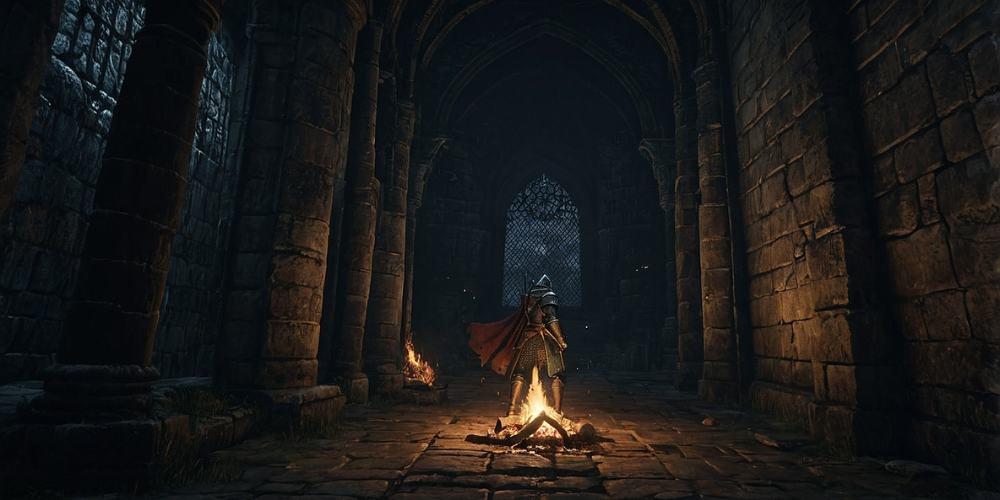Unraveling Environmental Storytelling Techniques in Dark Souls
Nov-04-2024

As I embarked on my adventure through the haunting landscapes of Dark Souls, I quickly realized that the game was more than just a challenge; it was an intricately woven tapestry of environmental storytelling. Each location felt like a chapter in a forgotten tale, filled with layers of narrative that begged to be uncovered. I found myself drawn into a world where every corner revealed whispers of past events, each object a relic of bygone conflicts. My exploration was as much about deciphering this silent language as it was about overcoming the relentless foes that stood in my way.
Setting the Scene
The moment I took my first steps into the dark, twisted realm of Lordran, I was struck by the contrasts that surrounded me. There was a sense of desolation mixed with beauty, a reflection of the world in its twilight. The ruins scattered across the landscape told stories of a once-thriving civilization, a melancholic reminder of what had been lost. As I traversed the dilapidated architecture of Undead Burg, I couldn’t help but feel the weight of history pressing down on me.
Symbolism in Design
One of the most striking elements of Dark Souls' storytelling is its use of architectural symbolism. The world felt like a giant puzzle, each area interconnected yet distinct. I noticed that the design of each environment hinted at its purpose and history. For instance, the lavish decorations of Anor Londo contrasted sharply with the grim atmosphere of Blighttown. This stark juxtaposition highlighted the societal decay that had swept through the land, allowing me to piece together the narrative without any explicit explanation.
Item Descriptions: Keys to the Past
As I discovered new items scattered throughout the world, I was captivated by their descriptions. These brief snippets of text provided crucial context for the items that I collected. They were like breadcrumbs leading back into the unfolding story of Lordran. Each weapon, piece of armor, or key item I found revealed bits of lore, shedding light on the characters and events that shaped this dark world. I discovered the tragic fate of various figures from the past, with some items providing hauntingly poetic insights into their lives.

The Significance of NPCs
The non-playable characters I encountered played a pivotal role in unfolding the story. Each character carried with them a sense of purpose, a mission intertwined with their histories. I found myself deeply invested in their stories, learning of their motivations and regrets. The melancholic dialogue offered glimpses into their past, further enriching the world’s tapestry. For instance, the mysterious figure of Solaire of Astora resonated with me, his pursuit of sunlight not merely a battle against darkness but also a quest for meaning in a forsaken realm.
Juxtaposition of Light and Darkness
The persistent theme of light versus darkness added a rich layer to the storytelling. I noted how the flickering flames from bonfires served as beacons of hope amid the encroaching shadow. Every time I rested at a bonfire, I felt a momentary reprieve from the oppressive atmosphere, a reminder of the struggle against despair. This duality was expertly reflected in the environments I explored; the gentle glow of the fire contrasted starkly with the cold, desolate areas filled with monstrous foes.
Culturally Rich Influences
Dark Souls drew heavily from various cultural and mythological influences, which contributed to its environmental storytelling. I was intrigued by the elements of Norse and Celtic mythology that woven through the game’s lore. The architecture and aesthetics of certain locations bore resemblances to ancient structures, prompting me to reflect on the way real-world cultures narrated their histories through their environments. It was as if the landscapes of Dark Souls were an homage to the way humanity has always told stories through the places we inhabit.
Memory and Loss
As I ventured deeper into the game, the themes of memory and loss became increasingly apparent. The remnants of long-gone civilizations, the spectral figures wandering the lands, and even the very ground I walked upon carried a sense of mourning. The feeling of loss was palpable; it was infused in every crevice of the world, shaping the lives of those who still clung to the past. I often pondered the idea that in order to understand the present, one must bear witness to the remnants of history. Dark Souls made me confront this unyielding truth at every turn.

Environmental Lore: A Story Through Scenery
The way environments were crafted also narrated a story of their own. Each area I explored, from the eerie depths of the Catacombs to the desolate ashlands of the Kiln of the First Flame, had its own unique ambiance that told tales of struggle and sacrifice. The skeletal remains scattered throughout the Catacombs told me of countless battles fought and lives lost. I felt a frenzied urgency to piece together the histories enshrined in the ruins as I made my way through these hallowed grounds.
Hidden Secrets and Subtle Narratives
Throughout my journey, I discovered that Dark Souls was rife with hidden secrets. These secrets often revealed additional layers of storytelling, encouraging exploration and rewarding curiosity. Sometimes, it was a hidden ledge that led to a treasure trove of lore; other times, it was a quiet area with environmental clues that hinted at significant events. Each discovery felt like a triumph, a chance to connect more deeply with the narrative and the world itself.
The Role of Nature
The inclusion of nature within the storytelling was another fascinating aspect. While many areas were marked by decay, nature often reclaimed its space. I found myself wandering through areas overtaken by vines, trees, and wildlife, witnessing the resilience of life amid destruction. This connection to nature emphasized the cycle of life and death, challenging the heavy themes of doom prevalent throughout the game. The forested areas provided a stark contrast to the harsh realities of the urban landscapes, further enriching the narrative experience.
Emotional Resonance
It’s remarkable how environmental storytelling in Dark Souls invokes powerful emotions. As I traversed the haunting landscapes, I frequently felt a deep sense of melancholy, a reflection of the fallen world around me. The ruined structures and doomed inhabitants resonated with my own feelings of strife, loss, and determination. The raw emotions crafted through the environment drew me deeper into the narrative, making each encounter and each location feel personal and significant.

My Journey Reflected in the World
As I explored Lordran, I noticed that my personal journey paralleled the narrative that unfolded around me. The tensions between hope and despair, light and darkness mirrored my own struggles as I faced the game’s formidable challenges. With every victory and defeat, I felt as though I was carving my own story within the grand tapestry of Dark Souls. The world became a living reflection of my journey, mutable and alive as it shifted based on my experiences.
Dark Souls as a Legacy
In unraveling the environmental storytelling techniques in Dark Souls, I realized that the game itself is a legacy—a tribute to the stories we craft through experiences and memories. As I pieced together the fragmented lore dispersed across the desolate landscapes, I felt a profound connection to the game and its world. It challenged me to contemplate the stories interwoven within the environments we inhabit and the hidden narratives lurking beneath the surface of our own lives.
The Silence Speaks Volumes
Ultimately, one of the most powerful aspects of Dark Souls' storytelling is its reliance on silence. The absence of overt narrative explanations allows the game’s environment to speak volumes. It demands that players engage deeply, interpreting the world through exploration and discovery. In this silence, I found profound truths—the acknowledgment of struggle, the beauty within decay, and the understanding that every end leads to a new beginning.
An Ending Yet Unsung
As I reached the climax of my journey through Dark Souls, I felt an overwhelming sense of reverence for the intricate storytelling woven through its environments. Each area, character, and item I encountered felt like a piece of a greater narrative, rich with meaning and history. The lessons learned and stories uncovered along the way lingered with me, a reminder that in the shadows of our struggles lie tales waiting to be told. The environmental storytelling of Dark Souls is a testament to the power of experience, memory, and the stories inherent in every corner of existence.







